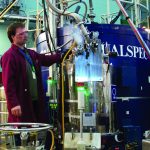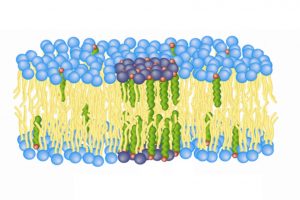Neutron Beams are Irreplaceable Tools for Materials Research
Scientists and engineers rely on a full suite of tools to unlock the secrets of materials, which use various probes such as visible light, lasers, ultrasound, microwaves, x-rays, and elections. Each tool reveals certain properties of materials, generating knowledge that points the direction for better understanding and improvements. Rarely does a single tool provide the complete picture.
The tools for material research range in scale from simple microscopes and lasers to regional or national facilities that are shared as major scientific infrastructure.

Canadian Light Source (Saskatoon, SK)

Canadian Neutron Beam Centre at the NRU reactor (Chalk River, ON)

Particle beamlines at TRIUMF (Vancouver, BC)
Three shared national facilities include the Canadian Light Source, TRIUMF and the Canadian Neutron Beam Centre, which provide x-rays, muons, and neutrons respectively to materials researchers across Canada.
 The knowledge generated using neutrons is complementary to, and cannot be replaced by, these other tools.
The knowledge generated using neutrons is complementary to, and cannot be replaced by, these other tools.
- Materials engineers need the penetrating power of neutron beams to examine the stresses deep inside critical industrial components that x-rays cannot penetrate.
- Biophysicists need the gentle probing of neutron beams to unravel the structures within biological membranes under life-like conditions.
- Chemists need the sensitivity of neutrons to detect hydrogen and understand chemical reactions to develop technologies such as fuel cells and hydrogen storage materials.

- Physicists need the electrically-neutral, yet magnetic, property of neutrons to better understand superconductivity and the magnetic structures of materials.
The world science community recognized the great importance of neutron beams when it awarded Bertram Brockhouse and Clifford Shull the Nobel Prize in Physics for pioneering their use. Over the past 20 years, about $20 Billion has been re-invested in the global network of about 20 major neutron beam facilities, demonstrating worldwide recognition of their value.
READ MORE
What makes neutrons so useful for probing materials?
Next
Where are neutron beam facilities in Canada, and what do they do?
Neutrons are right-sized for atomic structures
 Scientists and engineers use neutron beams to explore the structure and dynamics of materials down to atomic length scales. Neutrons can be used to examine most materials, including metals, alloys, ceramics, composites, polymers, nano-structures, bio-materials, drugs, foods, liquids, colloids and gels.
Scientists and engineers use neutron beams to explore the structure and dynamics of materials down to atomic length scales. Neutrons can be used to examine most materials, including metals, alloys, ceramics, composites, polymers, nano-structures, bio-materials, drugs, foods, liquids, colloids and gels.
Thermal neutrons’ wavelengths match typical interatomic separations in solids. So thermal neutrons are able to probe the atomic arrangements in these systems. Thermal neutrons’ energies match the energies of many of the excitations existing in solids. So thermal neutrons are able to measure the energies of these atomic motions.
Cold neutrons have larger wavelengths that match larger molecules such as proteins and lipids that our bodies are made of. So cold neutrons are especially useful for life sciences and health research.
Neutrons are penetrating but non-destructive

Liquid helium cools a material near -270°C while it is being studied.

Examining stress inside a car engine block
Because they are penetrating, yet gentle, it is easy to obtain the bulk properties of large samples, or to measure stress deep inside parts of cars and planes to ensure they will perform safely in operation. In addition, this makes it easy to study materials in realistic conditions because complex chambers, such as cryostats, furnaces, pressure cells, can be used to control the environment of the material being studied during the experiment.
Neutrons are non-destructive and highly penetrating because they are uncharged, and the typical energies of thermal neutrons are in the range of 3 – 300 millielectron volts (meV). Their energies are a million times less than x-rays with the same wavelengths in the range of 0.5 – 5 angstroms (Å). Although these neutron energies are very low, neutrons penetrate easily through many centimetres of most materials, so that truly representative sampling of bulk materials is possible, completely non-destructively.
Neutrons are magnetic, yet neutral
Although neutrons have no charge, they have a magnetic moment that interacts with the magnetic electrons in atoms. The interaction is simple and well known, making neutron beams the absolute reference technique for determining the structure and dynamics of magnetic materials. This is especially useful for studying materials for computer memory or quantum materials such as superconductors.
Neutrons are sensitive to isotopes
 Unlike x-rays, neutrons can easily distinguish between neighboring elements of the periodic table, and neutrons make it as easy to see light atoms (e.g. hydrogen, lithium) as heavy atoms (e.g. manganese, uranium). Neutrons can be used to unravel the complex structures of biological materials and polymers in which hydrogen is a major constituent.
Unlike x-rays, neutrons can easily distinguish between neighboring elements of the periodic table, and neutrons make it as easy to see light atoms (e.g. hydrogen, lithium) as heavy atoms (e.g. manganese, uranium). Neutrons can be used to unravel the complex structures of biological materials and polymers in which hydrogen is a major constituent.
That’s because neutrons interact directly with the nucleus of the atom, and thus determine the centre of mass of an atom that is free of electronic influences. The strength of the interaction varies from one nucleus to another but is similar in magnitude. Most notable is the huge difference between light hydrogen and heavy hydrogen (i.e. deuterium), enabling ‘contrasting matching’ by substituting deuterium for hydrogen, thereby making the measurements in biology and polymer chemistry much more sensitive.
Neutrons interact with matter simply
Neutrons’ weak interactions with matter greatly ease the interpretation of neutron scattering data. The cross-section contains terms dependent on the neutron interaction, which are known, and terms dependent on the properties of the system under investigation. The experimental results thus give direct information about the microscopic properties of the system of interest.
Due to these properties, neutron beams will always be an indispensable tool and cannot be replaced by other techniques.
